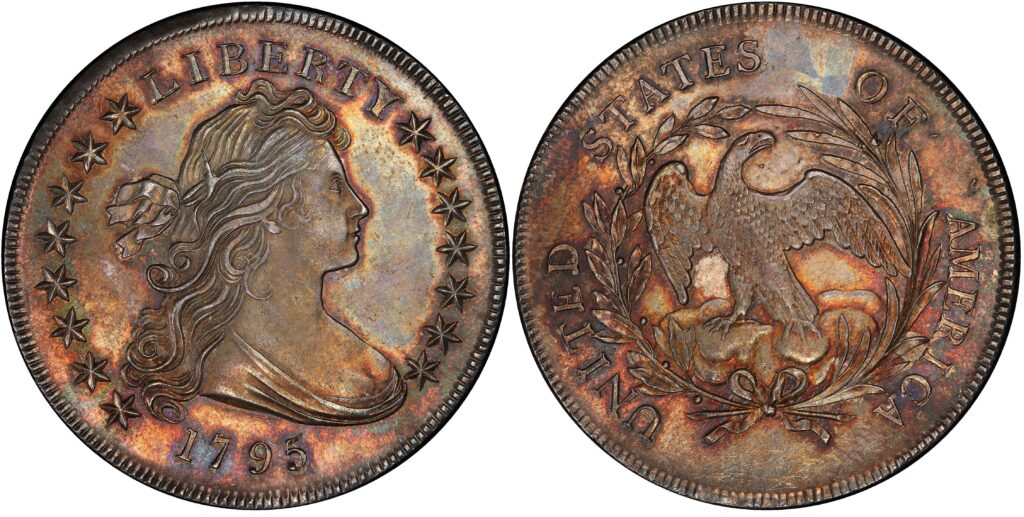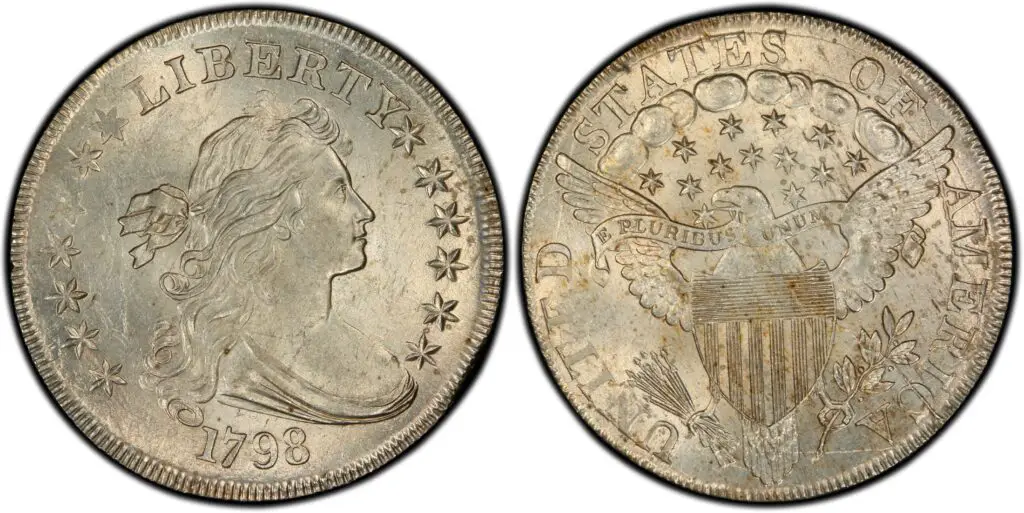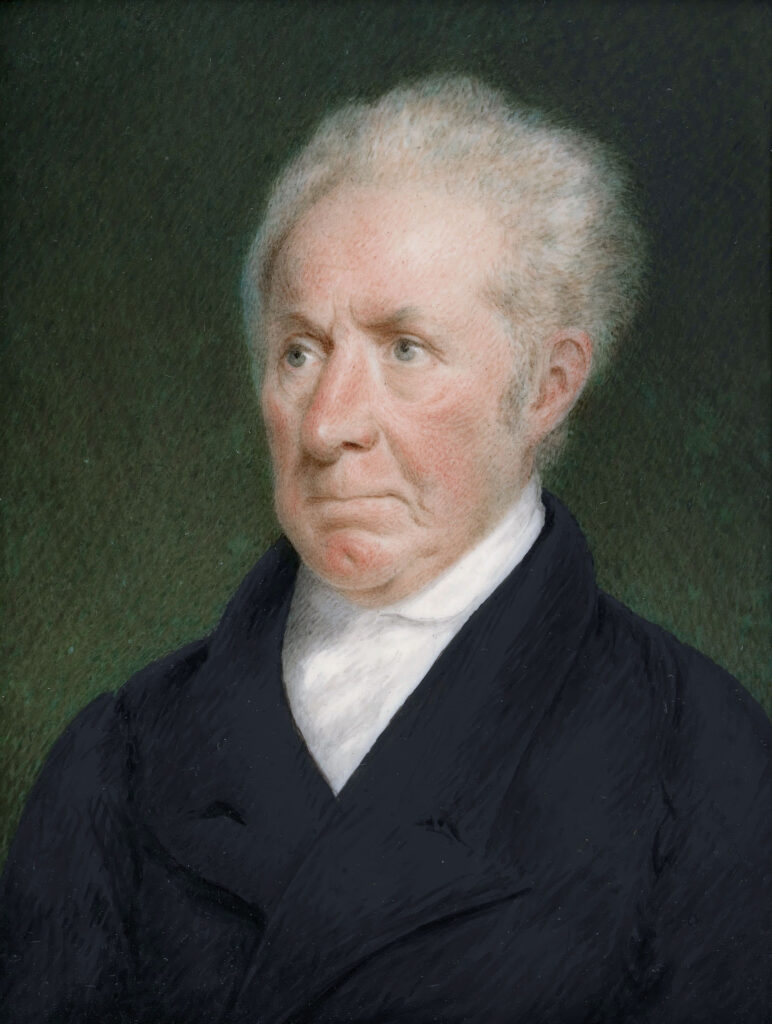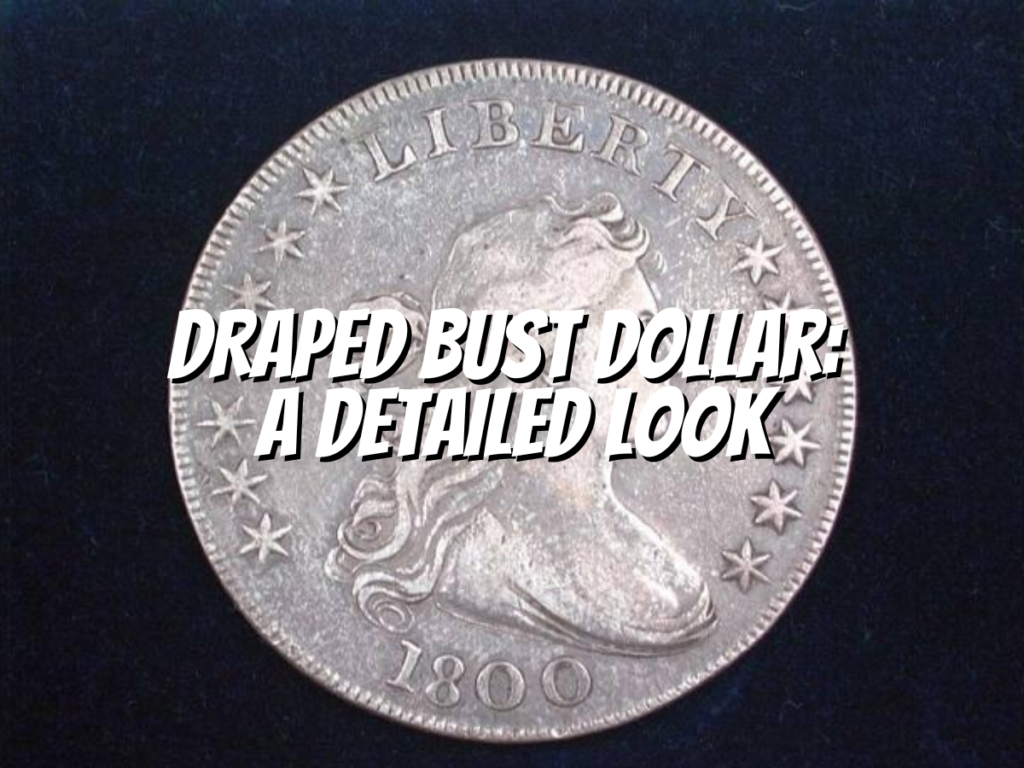The Draped Bust dollar was issued by the United States Mint from 1795 to 1803, again beginning in 1804 and continuing through the 1850s.
The Flowing Hair dollar, the first silver dollar struck by the United States Mint, was replaced by this design in 1794. In this article, we’ll take a detailed look at this coin! Let’s dive right in!
History Of Draped Bust Dollar

Elias Boudinot, the newly appointed Director of the Mint, mandated in October 1795 that the dollar be minted in silver of legal fineness of 0.892 (89.2%) rather than the unauthorized quality of 0.900 (90%) silver that had been used since the denomination’s inception in 1794.
As the 18th century ended, fewer silver dollars were minted because less silver was being deposited at the Philadelphia Mint.
Silver dollar production ceased in 1804, with 1803 being the final year of regular mint production. A special set of proof silver dollars was struck in 1834 to supply a diplomatic mission to Asia.
As a result of officials’ misconception that dollars had last been minted in 1804, the year the coins were struck was used instead.
The Mint only struck a small number of 1804 dollars in subsequent years, so genuine examples are extremely hard to come by and highly sought after.

Silver coins were required to be struck from an alloy containing 89.2% silver and 10.8% copper per the Coinage Act of 1792.
Officials at the Mint hesitated to strike coins with such a high fineness, so it was decided to strike them in an illegal alloy of 90% silver.
As a result, silver depositors experienced a loss when their metal was converted into coins. The Flowing Hair Dollar was reissued after its initial year of circulation because of a redesign. The reasons for this shift and the individuals who proposed it are mysterious.
However, numismatic historian R.W. Julian has hypothesized that Henry William de Saussure, appointed Mint Director on July 9, 1795, may have been behind it. The Flowing Hair style may have been abandoned because it was widely disliked.
Design & Production
Although the coin’s designer is unknown, the artist Gilbert Stuart is generally credited with creating it.
In the 1850s, then-Mint Director James Ross Snowden interviewed Stuart’s descendants, who claimed their ancestor was the coin’s designer.
It has been speculated that Ann Willing Bingham, a socialite from Philadelphia, served as the coin’s model.


Following public and Congressional complaints about the shortage of small change in circulation, Boudinot began asking silver depositors for smaller denominations in 1801 rather than the silver dollars that had previously been requested.
As a result, Boudinot convinced many depositors to accept their silver in small denominations. Boudinot tried to stop making silver dollars in 1803 and instead issued half dollars, even though the Mint’s silver bullion reserves had grown.
Production of silver dollars ended in March 1804, but the minting of the 1803 dollar continued until then.
There were 85,634 1803 dollars printed in total. After being asked to do so by the Bank of the United States, production of silver dollars and gold eagles was formally halted in 1806 by Secretary of State James Madison.
The “1804” Dollars
On April 18, 1831, after Mint Director Samuel Moore submitted a request to the Treasury, President Andrew Jackson authorized the resumption of silver dollar coinage.
To represent American business interests in Asian monarchies like Muscat and Siam, Edmund Roberts was appointed to the post in 1834. Roberts suggested that proof coins be presented to the honored guests.

No U.S. dollars had been minted since 1804, even though their production had been authorized in 1831. Moore discovered that 1804 was the final year for silver dollar production by speaking with Chief Coiner Adam Eckfeldt, who had been with the Mint since its inception in 1792.
Neither realized it then, but 1803 was listed as the final production year. The presentation pieces were struck with the year 1804 because that was the year they thought the last striking occurred.
No one knows why the current date wasn’t used, but R.W. Julian speculates that it was so collectors wouldn’t be disappointed when they couldn’t get their hands on the newly dated coins.
In November 1834, mints began producing the first 1804 dollar coins (along with the remaining coins in the sets).
Two more sets were forged as Roberts’ planned trip to Indo-China (then called Annam) and Japan quickly grew in scope.
The Mint struck only eight known examples of Class I 1804 dollars. In April of 1835, before embarking on his journey, Roberts gave a set to the Sultan of Muscat and another to the King of Siam.
As part of a diplomatic gift exchange, the Sultan of Muscat was given an elephant, and the Washington Zoo was given a male and female lion.
After becoming ill in Bangkok, Roberts was transferred to Macao, where he ultimately passed away in June 1835. After Roberts’ passing, the remaining two sets were returned to the Mint instead of being given to the VIPs.
Collecting
The 1804 dollar first gained widespread attention among coin collectors after the 1842 publication of A Manual of Gold and Silver Coins of All Nations, Struck Within the Past Century by Jacob R. Eckfeldt (son of Adam Eckfeldt) and William E. Du Bois.
Several coins, including a dollar from 1804, were taken from the Mint’s coin cabinet and reproduced in the book by tracing a pantograph stylus over an electrotype.
In May 1843, numismatist Matthew A. Stickney acquired an 1804 dollar from the Mint’s cabinet. Mint officials, led by Director Snowden, began striking more restrikes of coins in response to rising demand for them in the 1850s.
Some of the 1804 dollars that were struck were sold by Mint employees for profit. When Snowden realized this, he returned and repurchased some of the coins.

Class II is the only known example of this type of coin, and it was struck over an 1857 shooting thaler, which Snowden later added to the Mint’s collection. The Class III dollar was named for the six pieces it contained because of the edge lettering added after striking. The 1804 dollar had more fame than any other American coin by the end of the 19th century.
A dollar from 1804 sold at auction in 1867 for $750 (about $15,704 today). A specimen sold for $700 ($18,105 in 2016 dollars) on November 27, 1874, seven years later.
The 1804 dollar became known as the “King of American Coins” after being promoted by coin dealer B. Max Mehl in the early 20th century.
The popularity of these coins grew steadily throughout the twentieth century, culminating in 1999 when a Proof-68 specimen sold at auction for a record $4,140,000.
Before you go…
The Draped Bust dollar is one of the most iconic coins in American history. It was the first silver dollar struck by the United States Mint, and it helped establish a standard for coinage that would be used for decades. If you’re looking for an interesting collectible or investment opportunity, this might be just what you need!
Check out my next article: “1992 Washington Quarters: A Closer Look“
Related Articles:

